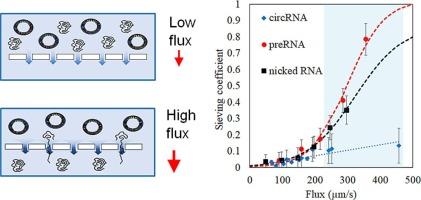Purifying circular RNA by ultrafiltration
IF 9
1区 工程技术
Q1 ENGINEERING, CHEMICAL
引用次数: 0
Abstract
Developing messenger RNA (mRNA) vaccines for COVID-19 renewed and intensified the interest in using mRNA for disease prevention and treatment. Despite their efficacy, linear mRNA molecules are short-lived in the human body, primarily due to enzymatic degradation at the free ends. In contrast, circular RNA (circRNA) exhibits enhanced stability and resistance to exonuclease degradation. However, this stability depends highly on purity. Unfortunately, the in vitro transcription (IVT)/self-splicing reaction to produce circRNA contains a mixture of circular and linear RNAs, and effective methods for purifying circRNA from solutions containing linear RNA contaminants do not exist. This study explored the feasibility of using ultrafiltration to purify protein-encoding circRNA produced by the self-splicing of a precursor RNA (preRNA) during IVT. We measured the sieving coefficients—a separation metric—of circRNA, linear precursor RNA, and nicked RNA conformers using polyethersulfone membranes with molecular weight cutoffs from 30 to 300 kDa, analyzing performance as a function of permeate flux. We also estimated the RNA critical fluxes and determined suitable operating conditions for purification. We achieved a purity of 86 % with a yield above 50 %. By comparison, the purity achieved by size-exclusion high-performance liquid chromatography (SE-HPLC), the leading alternative separation technology, was 41 %, with a yield of 45 %. These findings highlight ultrafiltration as a superior method for purifying circRNA at the research scale. Since ultrafiltration is already established as a scalable process in bioprocessing, this research may serve as a foundational step toward enabling large-scale manufacturing of circRNA-based therapeutics.

超滤法纯化环状RNA
为 COVID-19 开发信使核糖核酸 (mRNA) 疫苗再次激发了人们对利用 mRNA 预防和治疗疾病的兴趣。线性 mRNA 分子虽然有效,但在人体内的寿命很短,主要原因是游离端的酶降解。相比之下,环状 RNA(circRNA)具有更高的稳定性和抗外切酶降解的能力。然而,这种稳定性在很大程度上取决于纯度。遗憾的是,产生 circRNA 的体外转录(IVT)/自我剪接反应含有环状和线性 RNA 的混合物,而从含有线性 RNA 杂质的溶液中纯化 circRNA 的有效方法尚不存在。本研究探讨了使用超滤技术纯化 IVT 期间前体 RNA(preRNA)自拼接产生的编码蛋白质的 circRNA 的可行性。我们使用分子量截止范围为 30 至 300 kDa 的聚醚砜膜测量了 circRNA、线性前体 RNA 和缺口 RNA 构象的筛分系数(一种分离指标),分析了性能与渗透通量的函数关系。我们还估算了 RNA 临界通量,并确定了合适的纯化操作条件。我们的纯度达到了 86%,产率超过 50%。相比之下,尺寸排阻高效液相色谱法(SE-HPLC)的纯度为 41%,产率为 45%,而尺寸排阻高效液相色谱法是最主要的替代分离技术。这些研究结果突出表明,超滤是在研究规模上纯化 circRNA 的一种优越方法。由于超滤已被确立为生物加工中的一种可扩展工艺,这项研究可作为实现大规模生产基于 circRNA 的疗法的基础步骤。
本文章由计算机程序翻译,如有差异,请以英文原文为准。
求助全文
约1分钟内获得全文
求助全文
来源期刊

Separation and Purification Technology
工程技术-工程:化工
CiteScore
14.00
自引率
12.80%
发文量
2347
审稿时长
43 days
期刊介绍:
Separation and Purification Technology is a premier journal committed to sharing innovative methods for separation and purification in chemical and environmental engineering, encompassing both homogeneous solutions and heterogeneous mixtures. Our scope includes the separation and/or purification of liquids, vapors, and gases, as well as carbon capture and separation techniques. However, it's important to note that methods solely intended for analytical purposes are not within the scope of the journal. Additionally, disciplines such as soil science, polymer science, and metallurgy fall outside the purview of Separation and Purification Technology. Join us in advancing the field of separation and purification methods for sustainable solutions in chemical and environmental engineering.
 求助内容:
求助内容: 应助结果提醒方式:
应助结果提醒方式:


